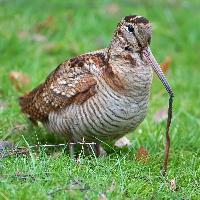
Állatleírás
The Pectoral Sandpiper, scientifically known as Calidris melanotos, is a captivating migratory bird that belongs to the Scolopacidae family, which encompasses waders or shorebirds. This species exhibits a fascinating blend of physical characteristics and behaviors that enable it to thrive across various habitats, primarily spanning the Arctic tundra for breeding and venturing to the southern hemisphere during the non-breeding season.Physically, the Pectoral Sandpiper is a medium-sized bird, measuring approximately 18 to 23 centimeters in length, with a wingspan that stretches around 38 to 42 centimeters. It possesses a relatively stout body, a short neck, and a small head, which gives it a distinctive profile among shorebirds. The bird's plumage is a study in subtle beauty and practical camouflage. Its back and wings are mottled with browns and blacks, blending seamlessly into the tundra landscape or muddy shores it frequents. The underparts are white, transitioning to a distinctive, sharply defined, pectoral band of dark streaks that gives the species its common name. This band is a key identifying feature, separating the breast’s white lower parts from the brownish upper parts. The bill is straight and of moderate length, enabling the bird to probe the soil for food, while its legs are yellowish-green, providing a slight pop of color against its otherwise earth-toned body.
One of the most intriguing aspects of the Pectoral Sandpiper is its migratory behavior. Breeding primarily in the Arctic regions of North America and Siberia, these birds undertake a remarkable journey to the southern reaches of South America, showcasing incredible endurance. During migration, they can be found in a variety of wetland habitats, from coastal mudflats to inland marshes, where they rest and refuel.
The diet of the Pectoral Sandpiper is as varied as its habitat, consisting mainly of insects, crustaceans, and other small invertebrates. This diet shifts depending on the bird's location and the availability of food sources. During the breeding season in the Arctic, for example, they consume a higher quantity of insects and larvae, while in their wintering grounds, their diet may include more aquatic organisms.
Breeding behavior of the Pectoral Sandpiper is equally fascinating. Males are known for their elaborate courtship displays, which include low, moaning flights and intricate dances intended to attract females. Nests are typically shallow depressions on the ground, lined with plant material, where the female lays and incubates a clutch of usually four eggs. Remarkably, after laying the eggs, the female's involvement ends, leaving the male to care for the hatched young until they are ready to fend for themselves.
Conservation-wise, the Pectoral Sandpiper is currently classified as being of Least Concern by the International Union for Conservation of Nature (IUCN), indicating that it does not face any immediate threats to its survival. However, like many migratory species, it is vulnerable to habitat loss and degradation, particularly in its migratory stopover and wintering grounds. Conservation efforts aimed at protecting wetland habitats are crucial for ensuring the continued survival and health of this and other migratory shorebird populations.
In conclusion, the Pectoral Sandpiper is a remarkable bird, whose annual migratory journey encapsulates the extraordinary feats of endurance and adaptation that define the avian world. Its presence enriches the ecosystems it inhabits, making it a species of interest not only for ornithologists but for anyone intrigued by the natural world's complexities and wonders.
Hasonló állatok
Új állatfotók
Top 10 állat
- Dolphin gull (Leucophaeus scoresbii)
- Diana monkey (Cercopithecus diana)
- Japanese macaque (Macaca fuscata)
- Stone loach (Barbatula barbatula)
- Galápagos tortoise (Geochelone nigra complex)
- Moustached guenon (Cercopithecus cephus)
- Russian tortoise (Testudo horsfieldii)
- Common house mosquito (Culex pipiens)
- Japanese spider crab (Macrocheira kaempferi)
- Giant peacock moth (Saturnia pyri)


